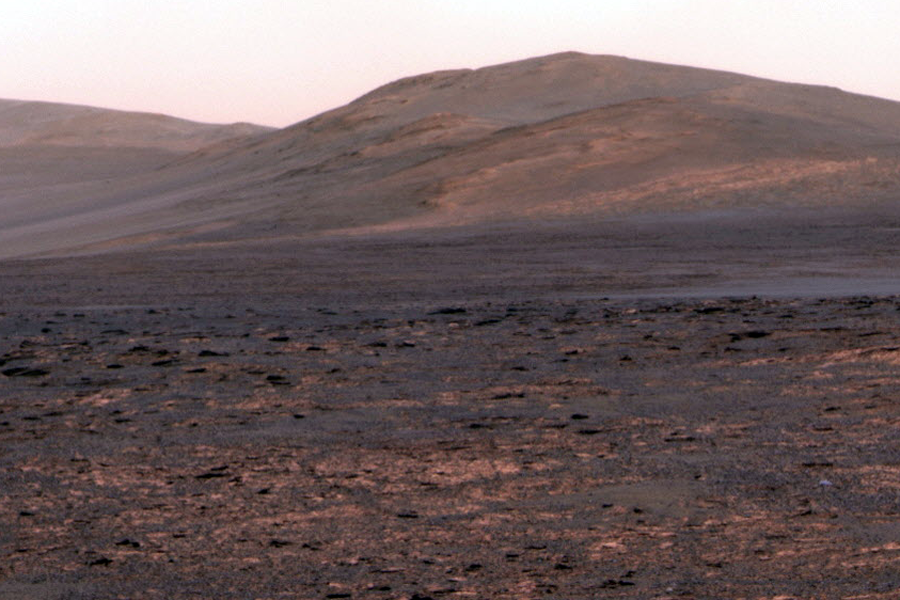When Mars was wet: How snow melt might have carved valleys
Loading...
On Earth, it's a familiar scene: winds driving soggy air up the slopes of a mountain range, where the moisture condenses, and precipitation leaves those windward slopes lush with vegetation and etched with valleys and ravines.
New research suggests that some 3.7 billion years ago, valley networks on slopes on Mars – minus the "lush" – may have been etched by the same process.
An international team of planetary scientists has shown that precipitation triggered or enhanced by this so-called orographic lift, could have played a role in carving networks of wide, shallow valleys that drop from ridges, peaks, and crater rims on the Martian highlands.
The work aims to help unpack details about Mars' climate during a period when water filled what are now dry river beds and and when clay-based minerals were forming.
These are conditions and processes "that point to a more hospitable climate than we currently have on Mars, one that could potentially have been more amenable to life," says Kathleen Scanlon, a PhD candidate at Brown University in Providence, R.I., and the lead author of the study, which is set to be published in the journal Geophysical Research Letters.
It's not clear whether the precipitation the study points to would have appeared mainly as rain or snow, since estimates of temperatures on Mars at that time depend on which climate model for Mars one uses, Ms. Scanlon notes.
For this study, the team, which included colleagues from Brown as well as scientists from the University of Chicago and the University of Paris, used a new model that yields colder average temperatures for the period, suggesting snow. The snow would have melted during periodic warm spells to provide the flowing water to carve the valleys.
Whatever form the precipitation initially took, the study suggests that atmospheric moisture played a key role in shaping the Martian surface, in addition to any contribution groundwater or melting of subsurface ice may have contributed early in Mars' history, the researchers say.
Moreover, the study's results suggest a range of densities for the atmosphere that could shed further light on the climate at the time, a period of transition from the Nochian to the Hesperian ages. During this transition, the red planet's climate is thought to have started its shift from what some researchers suggest was a relatively warm, wet period to the chilled, dessicated climate the planet hosts today.
The valleys in question are on the order of a few hundred yards deep and a few miles across, Skanlon says. These valleys host what appear to be river beds that are up to 300 feet wide. Some of these river channels run for hundreds of miles.
The team picked land forms that dated to the Nochian-Hesperian transition because earlier features would have been heavily eroded and so harder to interpret, while later features might have been tough to distinguish from valleys cut by the melt of ice on the slopes of erupting volcanoes. The solar system's largest mountain, the volcano Olympus Mons, is thought to have formed during the Hesperian age.
The team identified four regions laced with networks of shallow valleys and river beds. Using a global climate model for Mars, they estimated broad wind patterns at the time, then fed those winds, along with the topographical data, into a smaller-scale model designed to study precipitation and orographic lift. They found that the model's most intense precipitation for the valley networks corresponded with the bunched, upslope areas where the networks originated. These networks and their areas of origin appear in images taken during NASA's Mars Global Surveyor and Mars Reconnaissance Orbiter missions.
One of those valley networks, Warrego Valles, also became a testing ground for estimating the Martian atmosphere's density back in the day.
The team presented its global model with an atmosphere at twice Earth's current sea-level pressure, or a pressure of 2 bar. Under that scenario, prevailing winds tended to be too weak and came from the wrong direction to dump precipitation in the right area to trigger the network's formation.
When the team dialed atmospheric pressure down to either 0.5 bar or 1 bar, precipitation shifted to the correct locations.
The next step is to see if the atmosphere could have held enough moisture to allow precipitation from orographic lift to play a significant role in forming the valley networks.
Other researchers have estimated the water-flow rates needed to form these networks. The next step, Scanlon says, is to see what it takes for Mars climate models to approximate the right precipitation rates over the right locations and compare the results with the estimates.








